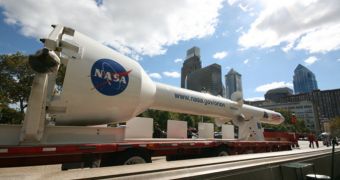NASA is organizing a cross-country trek for a full-scale mock-up of the Orion Launch Abort System (LAS), the segment of the rocket that is supposed to ferry astronauts to safety in case of an emergency.
As part of the canceled Project Constellation, the LAS was supposed to sit atop the Orion Crew Exploration Vehicle, which was to be mounted on the ARES I delivery system.
In case of a malfunction during take-off, the LAS was to engage its rocket motors, separating Orion from the carrier rocket, and ferrying it to safety a few miles away.
Any potential astronauts in danger would have felt a large jolt as the engines ignited, but at least they would have been safe from any potential explosion that may have occurred at the launch site.
A mock-up of this safety system is now making its way through the United States, being displayed to the public in museums and science centers.
The general public can learn a lot more about the LAS and Orion while the mock-up is on display. Experts with the program are always on-site, to explain the basic principles of the safety system.
In addition to placing the actual LAS on display, booths are also set up nearby, so that engineers with Lockheed Martin, the main contractors, and ATK, the primary subcontractor, can explain Orion spacecraft operations in detail.
“This LAS pathfinder was used by ground crews to practice lifting and stacking operations at the launch pad to help prepare for handling the actual flight hardware used in the flawless Pad Abort 1 (PA-1) test flight,” said Heather McKay for Ken Kremer of SpaceRef.
“The LAS is the highest thrust and fastest acceleration abort system ever tested. This is the only abort system of its kind in the world and its state of the art,” she added.
“It is equipped with three types of solid rocket motors. The innovative abort system will significantly improve astronaut safety for future human space flight,” she went on to say.
At this point, NASA plans to conduct its first orbital test flight of the Orion spacecraft by no later than 2013. The spacecraft will most likely take off from pad 39B at the Kennedy Space Center (KSC).
The faith of the manned space capsule has yet to be determined, as a new NASA bill shifted the goal of the American space program from exploring the Moon to visiting near-Earth objects (NEO) by 2025.
By the late 2030s, NASA wants to put an astronaut crew on Mars. Exploring low-Earth orbit (LEO) and the Moon will most likely be carried out by privately-developed spacecraft.

 14 DAY TRIAL //
14 DAY TRIAL //